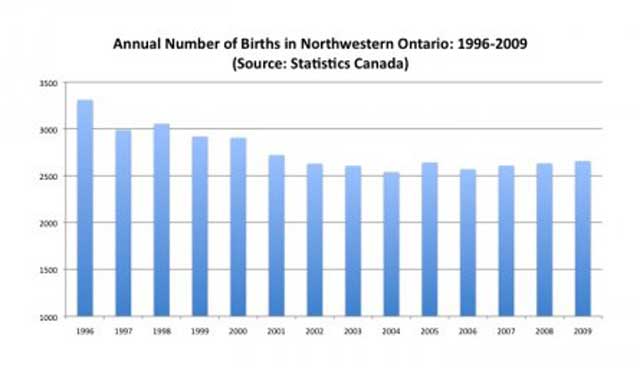 THUNDER BAY – The 20th century fertility decline that affected most western countries was also a Canadian phenomenon and even in northwestern Ontario, annual births and birth rates have fallen. Statistics Canada data on the total number of births annually show that the total number of births in Northwestern Ontario (Districts of Thunder Bay, Rainy River and Kenora) fell from 3,311 in 1996 to a low of 2,540 by 2004 – a 23 percent decline.
THUNDER BAY – The 20th century fertility decline that affected most western countries was also a Canadian phenomenon and even in northwestern Ontario, annual births and birth rates have fallen. Statistics Canada data on the total number of births annually show that the total number of births in Northwestern Ontario (Districts of Thunder Bay, Rainy River and Kenora) fell from 3,311 in 1996 to a low of 2,540 by 2004 – a 23 percent decline.
However, since 2004 there has actually been a recovery in the number of births and they have risen from 2,540 to 2,658 – an increase of about 5 percent. While these figures provide no such insight, the aboriginal population is a factor in the recent increases. The accompanying figures show the annual number of births both for the region as a whole and then separately by district.
Over the period 1996 to 2004, the biggest drops were in Thunder Bay District and Rainy River at about 27 percent each. Kenora District only dropped by about 15 percent. Since 2004, Kenora District has also seen the biggest recovery with an increase of 9 percent followed by Thunder Bay District at just over 3 percent. Rainy River District, however, has continued to decline and the number of births shrank by almost 7 percent since 2004.
 Of the three districts, Kenora is the most fertile as in 2009 there were 1067 births for a population of 64,419 whereas in Thunder Bay District there were 1,379 births but for a much larger population of 149,063. In per capita terms, Kenora District has the much higher birth rate. The rise in the number of births bodes well for future population growth at least in the medium term particularly in the Kenora District.
Of the three districts, Kenora is the most fertile as in 2009 there were 1067 births for a population of 64,419 whereas in Thunder Bay District there were 1,379 births but for a much larger population of 149,063. In per capita terms, Kenora District has the much higher birth rate. The rise in the number of births bodes well for future population growth at least in the medium term particularly in the Kenora District.
Livio Di Matteo
 Livio Di Matteo is an economist in Thunder Bay, Ontario specializing in public policy, health economics, public finance and economic history. Livio Di Matteo is a graduate of the Fort William Collegiate Institute (1898-2005) whose school motto “Agimus Meliora” has served as a personal inspiration. Livio Di Matteo holds a PhD from McMaster University, an MA from the University of Western Ontario and an Honours BA from Lakehead University. He is Professor of Economics at Lakehead University where he has served since 1990. His research has explored the sustainability of provincial government health spending, historical wealth and asset holding and economic performance and institutions in Northwestern Ontario and the central North American economic region. His historical wealth research using census-linked probate records is funded by grants from the Social Sciences and Humanities Research Council of Canada. He has constructed, assembled and analyzed nearly 12,000 estate files for Ontario over the period 1870 to 1930. Livio Di Matteo writes and comments on public policy and his articles have appeared in the National Post, Toronto Star, the Winnipeg Free Press and Thunder Bay Chronicle-Journal and NetNewsledger.com. Livio Di Matteo has had an entry in Canadian Who’s Who since 1995.
Livio Di Matteo is an economist in Thunder Bay, Ontario specializing in public policy, health economics, public finance and economic history. Livio Di Matteo is a graduate of the Fort William Collegiate Institute (1898-2005) whose school motto “Agimus Meliora” has served as a personal inspiration. Livio Di Matteo holds a PhD from McMaster University, an MA from the University of Western Ontario and an Honours BA from Lakehead University. He is Professor of Economics at Lakehead University where he has served since 1990. His research has explored the sustainability of provincial government health spending, historical wealth and asset holding and economic performance and institutions in Northwestern Ontario and the central North American economic region. His historical wealth research using census-linked probate records is funded by grants from the Social Sciences and Humanities Research Council of Canada. He has constructed, assembled and analyzed nearly 12,000 estate files for Ontario over the period 1870 to 1930. Livio Di Matteo writes and comments on public policy and his articles have appeared in the National Post, Toronto Star, the Winnipeg Free Press and Thunder Bay Chronicle-Journal and NetNewsledger.com. Livio Di Matteo has had an entry in Canadian Who’s Who since 1995.
This article was originally posted on Livio Di Matteo’s NORTHERN ECONOMIST Blog at http://ldimatte.shawwebspace.ca.






